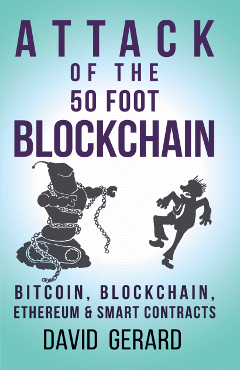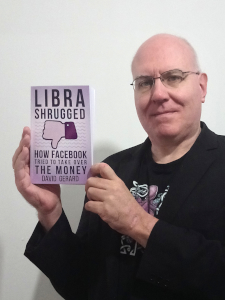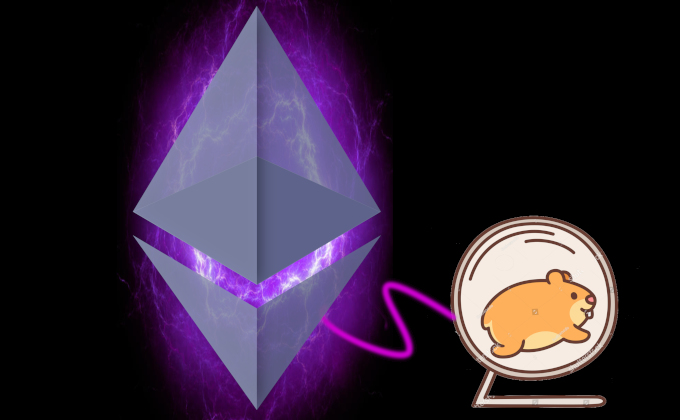Attack of the 50 Foot Blockchain
Blockchain and cryptocurrency news and analysis by David Gerard
After eight years of promises that Ethereum would definitely get off the blithering idiocy of proof-of-work cryptocurrency mining … the merge of the ETH blockchain into the new Beacon Chain system, formerly ETH2, is scheduled for some time between 15 and 20 September 2022.
If it happens this time, then hooray! Proof-of-work mining is a crime against humanity. Using a country’s worth of electricity, and thus pumping huge amounts of carbon dioxide into the air, is unconscionable.
But that won’t suddenly make cryptocurrency good. Proof-of-stake still doesn’t fix all the other problems with Ethereum, or cryptocurrency more broadly.
Decentralisation is always fake. Proof-of-stake pretends to change that — and it just doesn’t.
And that’s before we get to the community angst over whether US-jurisdiction validators will follow OFAC sanctions because they have to.
Proof-of-stake will still be a vast improvement over proof-of-work. And will cause much-needed political problems for bitcoin’s proof-of-work.
In all other senses, none of this matters.

Proof-of-work (POW) cryptocurrency mining was invented for bitcoin. Satoshi Nakamoto needed a way to add transactions to a ledger, making sure nobody spent a coin twice — but without any central authority. And he also wanted to distribute fresh bitcoins. So he paid the transaction processors with a bitcoin reward.
If you just give coins to anyone who asks, you don’t know if it’s a thousand people asking … or one person with a thousand sockpuppets. So Satoshi required an unforgeable commitment for everyone who wanted the bitcoin reward: competitive waste of resources.
You throw away computing power as fast as possible to show you deserve the bitcoins. Your chance of winning the bitcoin lottery is in direct proportion to how much you waste.
Bitcoin mining now uses over 0.5% of all the electricity in the world — for the same seven transactions per second it managed to do in 2009. Bitcoin is the most inefficient payment system in human history.
Ethereum copied bitcoin’s stupid system, because they didn’t have anything better that they could claim was decentralised.
Proof-of-stake (POS) was first proposed by BitcoinTalk user QuantumMechanic on 11 July 2011. You show your commitment by holding coins. Your chance to validate the next block and get the coins is proportional to your current holding: [BitcoinTalk]
I’m wondering if as bitcoins become more widely distributed, whether a transition from a proof of work based system to a proof of stake one might happen. What I mean by proof of stake is that instead of your “vote” on the accepted transaction history being weighted by the share of computing resources you bring to the network, it’s weighted by the number of bitcoins you can prove you own, using your private keys.
POS is a bit too obviously “thems what has, gets” — so you have to convince the users to go along with it.
There was zero chance that bitcoin would adopt POS. But many minor altcoins seized upon POS — just on the basis that they needed something to let them pretend to be decentralised that wasn’t POW, and this was something. Most remained functionally centralised in practice.
There are many ways to do a proof-of-stake system. Ethereum’s new mechanism is the Beacon Chain.
A participant validates a block of transactions. Other validators then confirm and attest that the block is valid. Once there are enough attestations, the new block becomes part of the Ethereum blockchain, and participants get a block reward of some ether. If a validator goes offline or attests to invalid transactions, it can lose its stake (“slashing”). [Ethereum.org]
To run a validator, you have to stake 32 ETH. Staked ether cannot be withdrawn as yet — that’s coming in a future version of Ethereum. For now, if you stake ether, it’s unavailable to you, and you just get block rewards back from your stake.
There are a fixed number of blocks to go on Ethereum, with the last being expected around 15 September. The Ethereum blockchain will then be continued by the Beacon Chain validators. [Twitter; bordel.wtf]
But none of the technical details matter — because all of this is handwaving to pretend that a system full of central points of control is “decentralised.”
The word “decentralised” is an attempt to abrogate legal culpability for what happens on your network, by claiming that your network doesn’t have any central points of control.
Proof-of-work has efficiencies of scale — so it naturally recentralises. By 2014, one miner had 51% of all bitcoin mining — when 51% had previously been the apocalypse scenario for bitcoin. By 2015, 80% of bitcoin miners stood on the same stage together.
Decentralisation has been fake ever since. “Decentralised” is a legal claim of untouchability — and not in any way an operational reality.
Ethereum copied bitcoin’s stupid system, and right now it uses as much electricity as a slightly smaller country. Ethereum has even fewer mining pools than bitcoin.
Proof-of-stake is a glaring case of “we need something, this is something, we’ll seize on this.” (Compare bitcoin seizing upon the Lightning Network.) The key point is to keep pretending that the system is meaningfully decentralised.
Staking is already as centralised as mining. The Lido staking pool plus the Coinbase exchange plus the Kraken exchange add up to over 54% of total stake. Thems what has, gets. [Etherscan]
The real central control point in Ethereum is Infura — an interface to the Ethereum blockchain owned by ConsenSys. Almost 100% of useful Ethereum transactions go through Infura, because coding to Infura is vastly easier than coding directly to the blockchain. Infura has been Ethereum’s central point of control for many years. [CoinDesk, 2018] Ethereum’s decentralisation is fake.
The Beacon Chain developers are not addressing the Infura problem in any manner whatsoever. They don’t seem to understand the question. They assume that if they can do everything via telnet to port 30303 by hand, then everyone else must surely be just as able to.
Beacon Chain developer Leonardo Bautista Gomez said: “if Infura goes down today, the blockchain is still moving” — as if that addresses in any manner the issue of miners/validators, exchanges and all the sites and DeFi apps that people actually use being on Infura. It’s centralised in practice, but it’s hypothetically decentralisable in the fabulous future! [Tech Monitor]
The final boss in Ethereum centralisation is, of course, the Ethereum Foundation. The behaviour of the blockchain is the behaviour of the code.
Ethereum miners are being told to just bugger off. They could decide to fork Ethereum!
A fork of Ethereum was tried once before. In 2016, The DAO was hacked. The Ethereum Foundation and a majority of mining power decided to violate the immutability of the blockchain and wind back The DAO — because immutability lasts precisely and only until the big boys lose enough money.
One group started Ethereum Classic (ETC), which didn’t wind back The DAO. Nobody ever used ETC for anything, and now it’s just another minor altcoin.
The winner for the title of official Ethereum will be the one the money backs. So far, the money is backing the Beacon Chain merge. Coinbase, the largest actual-dollar exchange, is assuming the merge is happening — in fact, Coinbase Prime is offering staking as a service. Circle, which issues the USDC stablecoin, has come out in ardent support for the merge. So has stablecoin issuer Tether. So the official Ethereum Foundation Beacon Chain is going to win. [Coinbase; Circle; Tether]
A lot of people in crypto expect the spurned miners to try to fork Ethereum. I expect nobody to care any more than they did about Ethereum Classic. [Fortune]
The staking model for Ethereum is probably an investment contract under the Howey test of whether something is a security under US law — and many people realised this years ago. [Grant Gulovsen, 2019]
Crypto people deal with this sort of glaringly obvious issue by putting their fingers in their ears and going “LALALALA,” so it’s back in the news now that the merge looks imminent. [CoinDesk]
Ethereum staking involves:
The SEC and the CFTC started looking into this question in 2019. [CoinDesk, 2019, archive]
Coinbase is offering staking as a service. The SEC won’t be a big problem here because they’re offering it only to institutional clients so far. But staking as a service is pretty clearly a security. [Coinbase blog]
The question is whether the SEC will be able to argue in a legally robust way that Ethereum validation in general is an investment contract — and that the ETH tokens involved are securities.
Ethereum mixer — i.e., money launderette — Tornado Cash was sanctioned by the US Treasury, via its Office of Foreign Assets Control (OFAC), on 8 August. This immediately entered discussions on the merge. Quite a chunk of staking is by entities who would likely be required to comply with US sanctions.
So what can a validator do? It’s easy not to process transactions that end in a Tornado Cash address. A validator could also refrain from attesting blocks containing sanctioned addresses — as even attesting to a sanctioned transaction could count legally as providing services to a sanctioned entity.
If enough validators censor sanctioned addresses, then those transactions will just … never enter the blockchain. 33% of validators acting together could block quite a lot of transactions. If 66% block particular addresses, those addresses are effectively blocked from Ethereum itself.
Brian Armstrong from Coinbase says that he’d rather shut down Coinbase’s staking product than censor transactions. [Twitter]
Luke Youngblood originally built Coinbase’s staking product. He says that all Coinbase’s validators are outside the US. However, Coinbase is still a US company. Does Coinbase feel lucky? [CoinDesk]
That said, I think it’s unlikely that OFAC will take action against validators — unless there’s North Korea levels of sanctions-breaking going on, and OFAC can’t find any other way to block it. OFAC did talk to Tornado Cash before bringing the hammer down.
US bitcoin miners don’t block transactions involving sanctioned entities — even though Marathon used to. OFAC hasn’t acted against the US bitcoin miners on this point.
But if OFAC tells US bitcoin miners or Ethereum validators that it wants those transactions blocked, they’ll have to do so.
If this happens, I don’t think OFAC-enforced transaction blocking will be met with a stirring rise of libertarian ideology. Approximately 100% of participants have a firm ideological commitment to being in it for the money.
Infura blocks for sanctions have caused a lot of trouble already for non-US Ethereum users. Nobody moved their stuff off Infura.
USDC is the dollar of choice in DeFi. Circle is already freezing sanctioned USDC — they’re a US entity, they have to.
If sanctioning Tornado Cash is the price of being able to use USDC and cash out at Coinbase, that will override all other considerations.
Proof-of-stake does not fix any of the other issues with cryptocurrency — because they’re implicit in the aims and design of cryptocurrency.
Transactions will still be irreversible — all errors, fat-finger fumbles and hacks are final. The cryptocurrency world considers this a feature, not a major failure of design from which every other problem follows.
The crypto world still runs on crank economics and crank politics. These people still consider they can code around all societal obligations, while espousing a variant of bitcoin Austrian economics. You can tell by the bleating about issuance of new ETH, as if this matters — there are more than enough large ether holders who could crash the market in a second if they were of a mind to.
About 100% of participants in the Ethereum ecosystem are in it for number go up. These are people who believe get rich schemes are real.
The Ethereum blockchain will still be clogged to unusability, and the gas fee structure will remain the same.
Validators will continue to front-run users. This would normally be considered a massive systemic failure, but the Ethereum Foundation has endorsed “MEV” (miner-extractable value) as just how things are. Remember: always declare your worst bugs are features, actually. [arXiv, PDF; Ethereum.org]
NFTs won’t have their current ghastly energy footprint, so that’s nice. NFT bros will still be NFT bros, scamming artists and each other. All your apes will still be gone.
We still need Ethereum to go proof-of-stake as absolutely soon as possible — because, apart from saving a country’s worth of electricity, it’ll put massive political pressure on bitcoin’s waste of a country’s worth of electricity.
The European Union’s mooted ban on proof-of-work didn’t go through this year, but it’s likely to be reintroduced to discussion: [Netpolitik, 2021, PDF]
If Ethereum is able to shift, we could legitimately request the same from BTC. We need to “protect” other crypto coins that are sustainable. Don’t see need to “protect” the bitcoin community.
I’m actually surprised that bitcoin advocates haven’t been working harder against the Ethereum merge.
End users should notice no difference whatsoever. Everything should just keep working the same. Barring an unforeseen disaster, there shouldn’t even be any downtime.
Nothing will be any faster. Gas fees will work on the same model. Miners will still front-run users.
Ethereum is a platform for applications. As long as the smart contracts tick along, you can run your penny stock frauds, and you can cash out your ether winnings at Coinbase, all is well. Nobody will care about any further details.
Centralisation doesn’t matter. The market never cared about the ideology of decentralisation — they’re in it for the money. If anyone cared about decentralisation, nobody would use Binance Smart Chain.
All the users want is a system that runs their EVM applications that they can cash out from easily. The Ethereum Foundation spent eight years trying to construct a mathematically robust proof-of-stake system … and it never mattered. The ideology was only ever marketing.
The Ethereum Foundation still claims that Ethereum will definitely do sharding some time in the fabulous future, to process the blockchain in parallel — faster than the maximum throughput of a single node. Presumably they’re betting that they can make sharding work without solving P=NP, which I strongly suspect was the problem they failed to work around when Casper proof-of-stake didn’t make it out of the door in 2018. Maybe they’ll finally all win Fields medals for successfully breaking mathematics.
But as long as DeFi can still rugpull, and Web3 can still incentivise securities fraud … the market won’t care about a few noisy weirdos tweeting ideology.
Your subscriptions keep this site going. Sign up today!
quote:
Everything should just keep working the same
You forgot the quotation marks around “working.”
Only in crypto world would buttcoin or ether be considered a working product. I guess unless you mean “working” as a speculative Ponzi scheme…it’s great at that!
I will miss the “but Proof of Stake is coming in six months” line, though. I’m curious about watching the miners “uh-uhh” and forking the chain. I hadn’t considered that at all!
It’s been nice seeing the prices wind down on graphics cards, I’ll admit. I had been babying my desktop over Covid because my Intel doesn’t have a video-out capability and I was terrified I would have to pay eBay scalpers if my current card crapped out…and I don’t consider used mining cards an option, even if they weren’t oc’d and drying fruit like in the past. You’ll never convince me that 1,000+ card lots run 24/7 would be a good, safe purchase for a simple gaming computer…I do hope some big data crunchers and machine learning facilities are stocked well a year from now, though!
Great article again, divabot!
true true, “‘”‘”working”‘”‘” i.e. in its usual perpetual state of collapse
So, is it me, or has PoS still not addressed the whole “costless alternate history” problem? Last I checked there was still no way to prevent people from attempting to fork from the last, where slashing is irrelevant. The official response last I checked was “it’s not decentralized anyway so we’ll just stop them…”
The Ethereum Foundation keeps giving away the game that they run the network, yes.
This may be unfortunate if EF principals keep saying things like how they’ll punish US stakers for following US laws.
I remember when decentralization was something to strive for. Apparently not. PoW puts more people in the game; more nodes.
POS will be controlled only by those who can afford to do so.
depends what you call a “node”. Also, huge mining pools are controlled by single entities.
Also, PoW is blitheringly stupid and a crime against humanity and needs to be stopped.
Your email address will not be published.
document.getElementById( “ak_js_1” ).setAttribute( “value”, ( new Date() ).getTime() );
This site uses Akismet to reduce spam. Learn how your comment data is processed.

Click here to get
signed copies of the books!
Hack through the blockchain bafflegab:
Attack of the 50 Foot Blockchain RSS – Posts
RSS – Posts RSS – Comments
RSS – Comments
Table of Contents
Index
The content of this site is journalism and personal opinion. Nothing contained on this site is, or should be construed as providing or offering, investment, legal, accounting, tax or other advice. Do not act on any opinion expressed here without consulting a qualified professional.
I do not hold a position in any crypto asset or cryptocurrency or blockchain company.
Amazon product links on this site are affiliate links — as an Amazon Associate I earn from qualifying purchases. (This doesn’t cost you any extra.)


